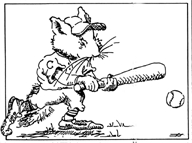 Last fall, fans of the St. Louis Cardinals cried "foul" over the
deafening racket caused by crowds at Minneapolis' Metrodome stadium
during crucial games of the World Series (the Minnesota Twins won it in
seven games).
Last fall, fans of the St. Louis Cardinals cried "foul" over the
deafening racket caused by crowds at Minneapolis' Metrodome stadium
during crucial games of the World Series (the Minnesota Twins won it in
seven games).
 Last fall, fans of the St. Louis Cardinals cried "foul" over the
deafening racket caused by crowds at Minneapolis' Metrodome stadium
during crucial games of the World Series (the Minnesota Twins won it in
seven games).
Last fall, fans of the St. Louis Cardinals cried "foul" over the
deafening racket caused by crowds at Minneapolis' Metrodome stadium
during crucial games of the World Series (the Minnesota Twins won it in
seven games).
Now Bill Clark--a hearing researcher in St. Louis and avid Cardinals fan--says he has evidence the noise really may have made a difference. Clark told a meeting of the Association for Research in Otolaryngology recently that noise levels he measured in the stands at the Metrodome were twice as loud as those at St. Louis' Busch Stadium. The crowd's roar in the concrete cave of the Metrodome very likely casued a temporary hearing loss in fans, stadium workers, and athletes alike, Clark says. (A contingent of Minnesota scientists at the meeting reportedly interrupted Clark's talk by singing the Twins' fight song and waving the "Homer hankies" made popular during the Series.)
Clart used a dosimeter (a computerized sound-level meter that records 1-second averages) to measure noise during game six in Minnesota (a Twins victory) and game four in St. Louis (where the Cards prevailed). Even during the quietest parts of the games, the noise averaged 92 decibels, compared with 83 decibels in St. Louis. "Perceptually, 92 decibels is twice as loud as 83 decibels," Clark says.
The Cardinals, usused to the noise level, may have had trouble hearing shouted signals and picking up auditory clues such as the sound of the bat hitting the ball. Clark thinks the Twins, who play 81 games in the stadium, have developed visual clues to offset the lost auditory ones. He notes that the Cards made four errors in Minnesota during the Series while the Twins made none at home.
Clark, a scientist with the Central Institute for the Deaf and the Department of Otolaryngology at Washington University, has also been working on how quickly the human ear can recover from loud noise. Together with colleagues at the institute and at Los Alamos National Laboratory he exposed chinchillas (a rodent with an ear structure and hearing similar to that of humans) to 95 decibels of sound for 15 minutes out of each hour. The tests lasted from 4 to 40 days. They found that while the rodents' hearing deteriorated as expected, after about 4 days it began to recover, even when the noise continued. At the end of 40 days, when all noise had been stopped, within 7 to 10 days the rodents' hearing returned to within 15 decibels of the normal range, considered clinically acceptable.
The question remains whether the noise-acclimated St. Louis Chinchillas can beat the Minnesota Twins in the next Series.